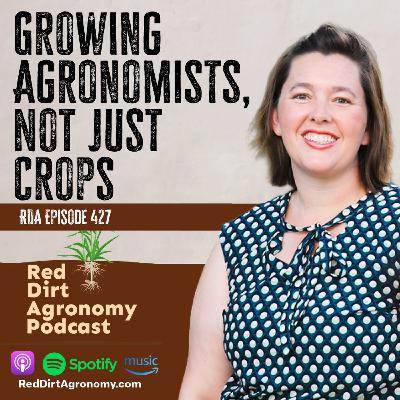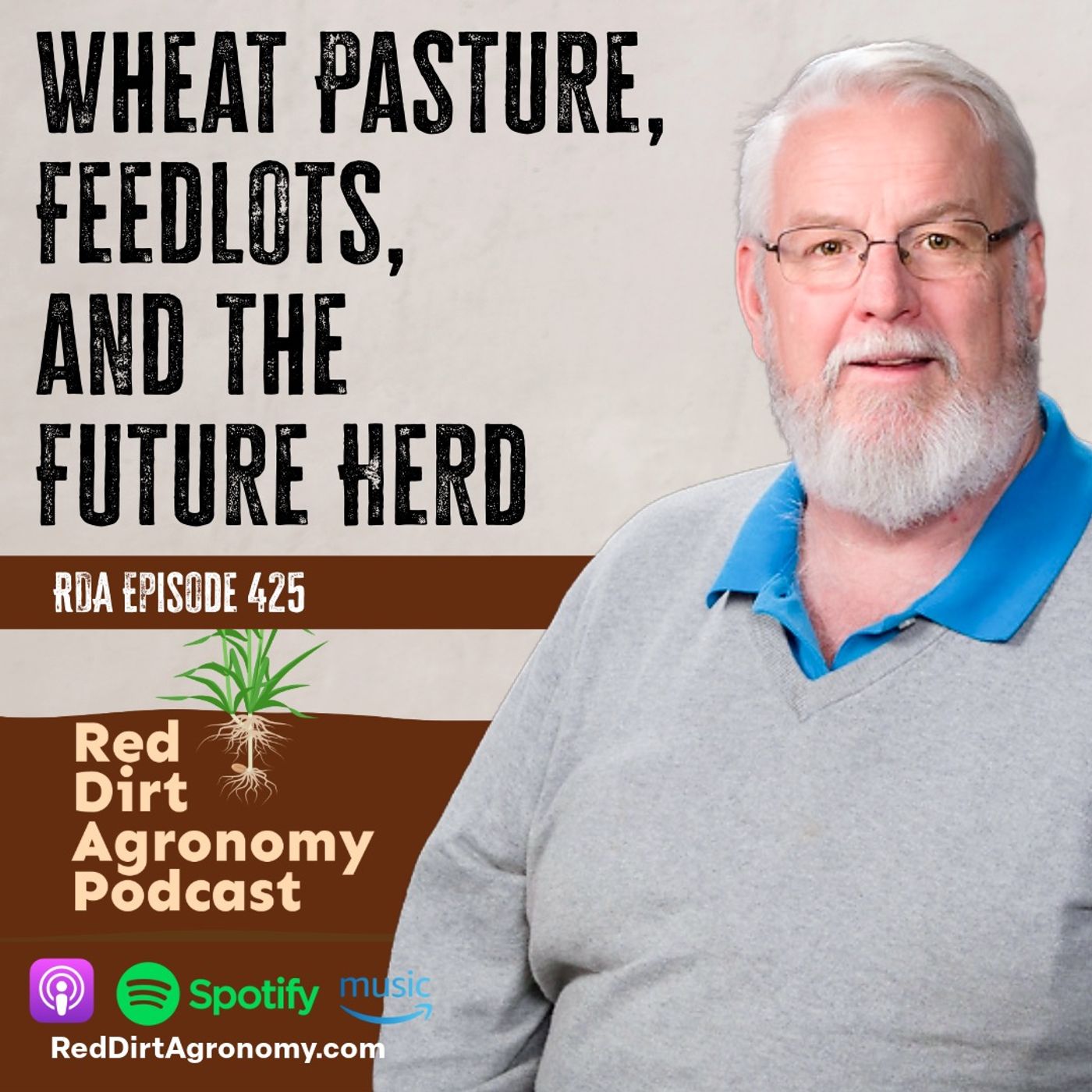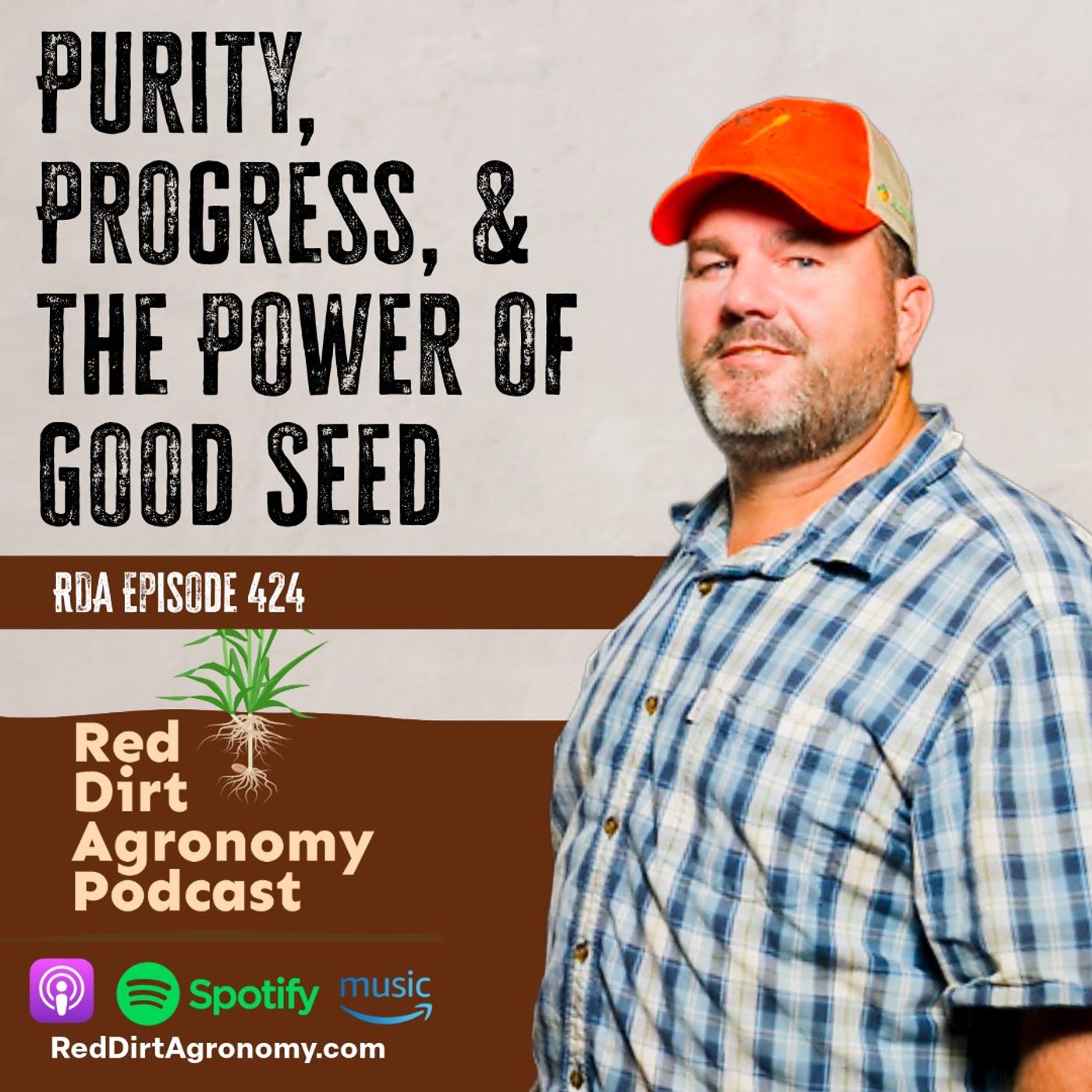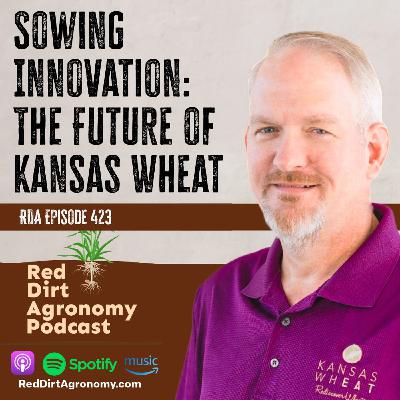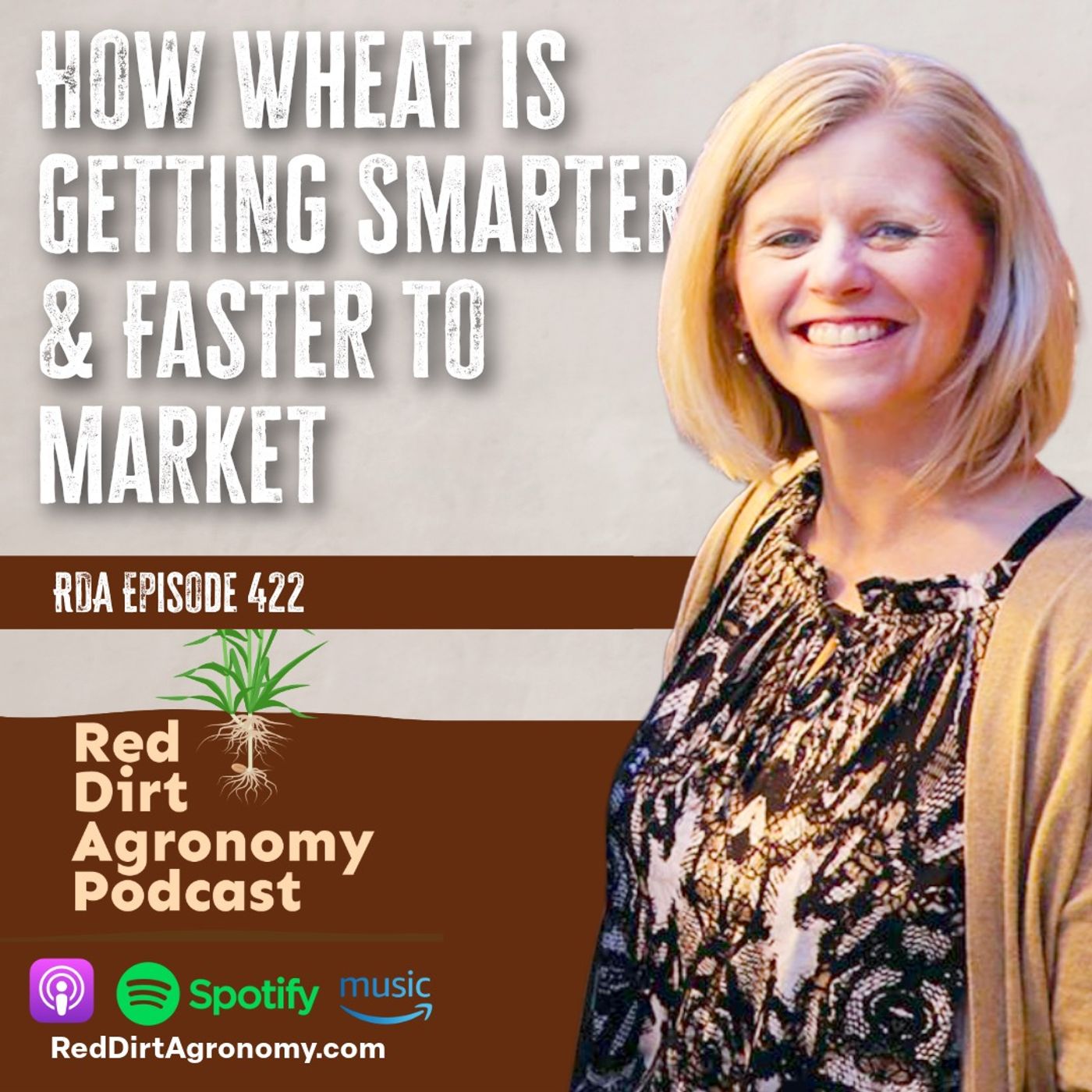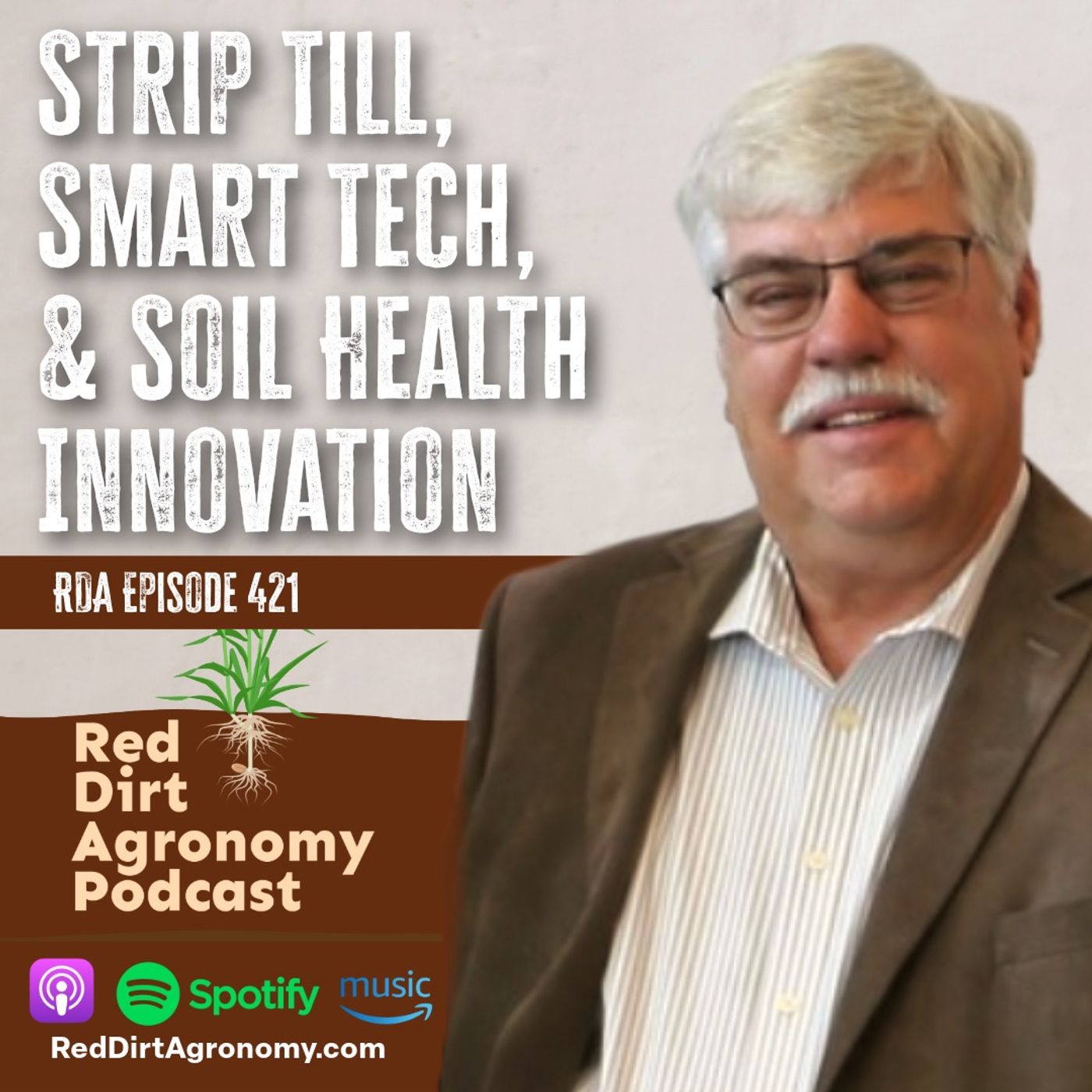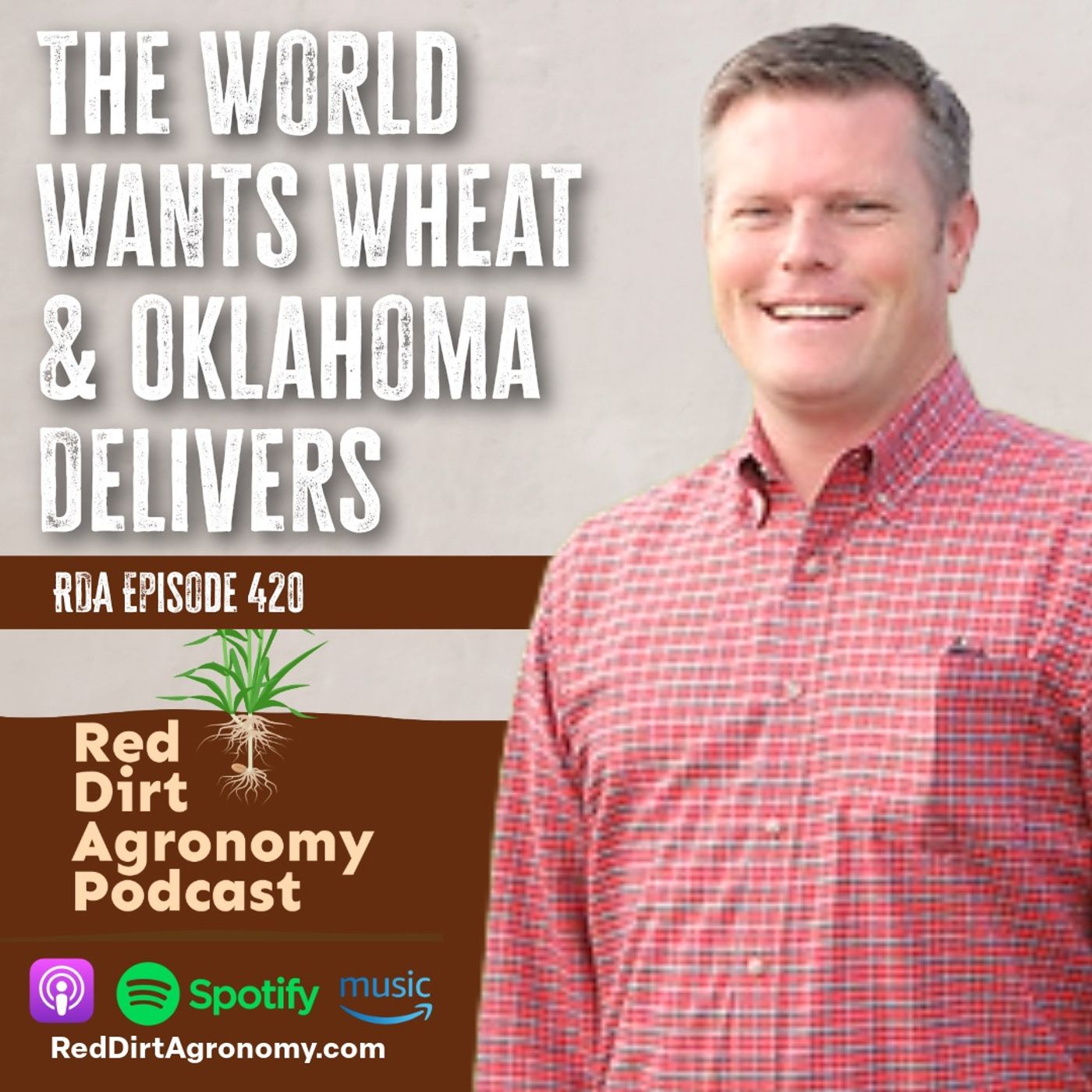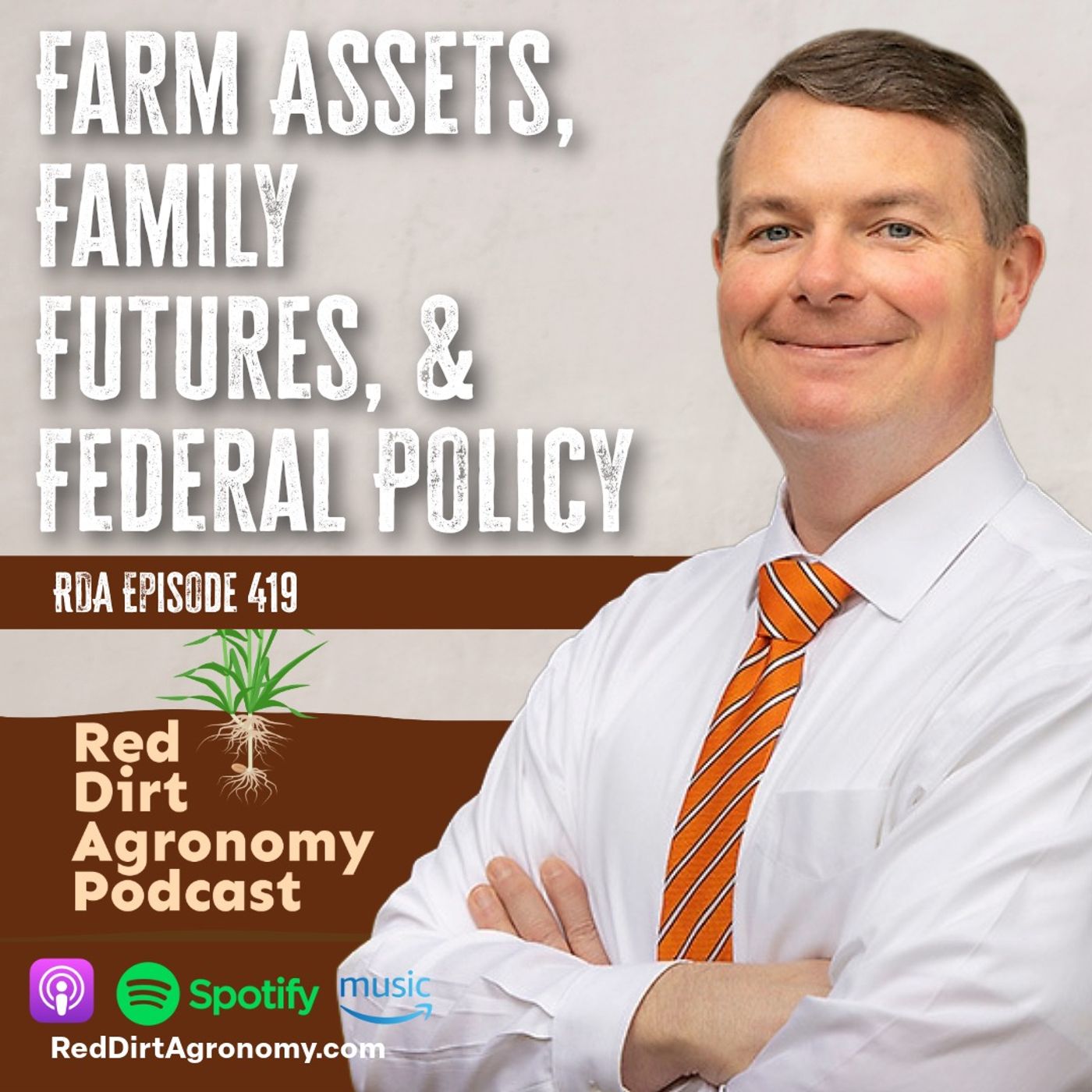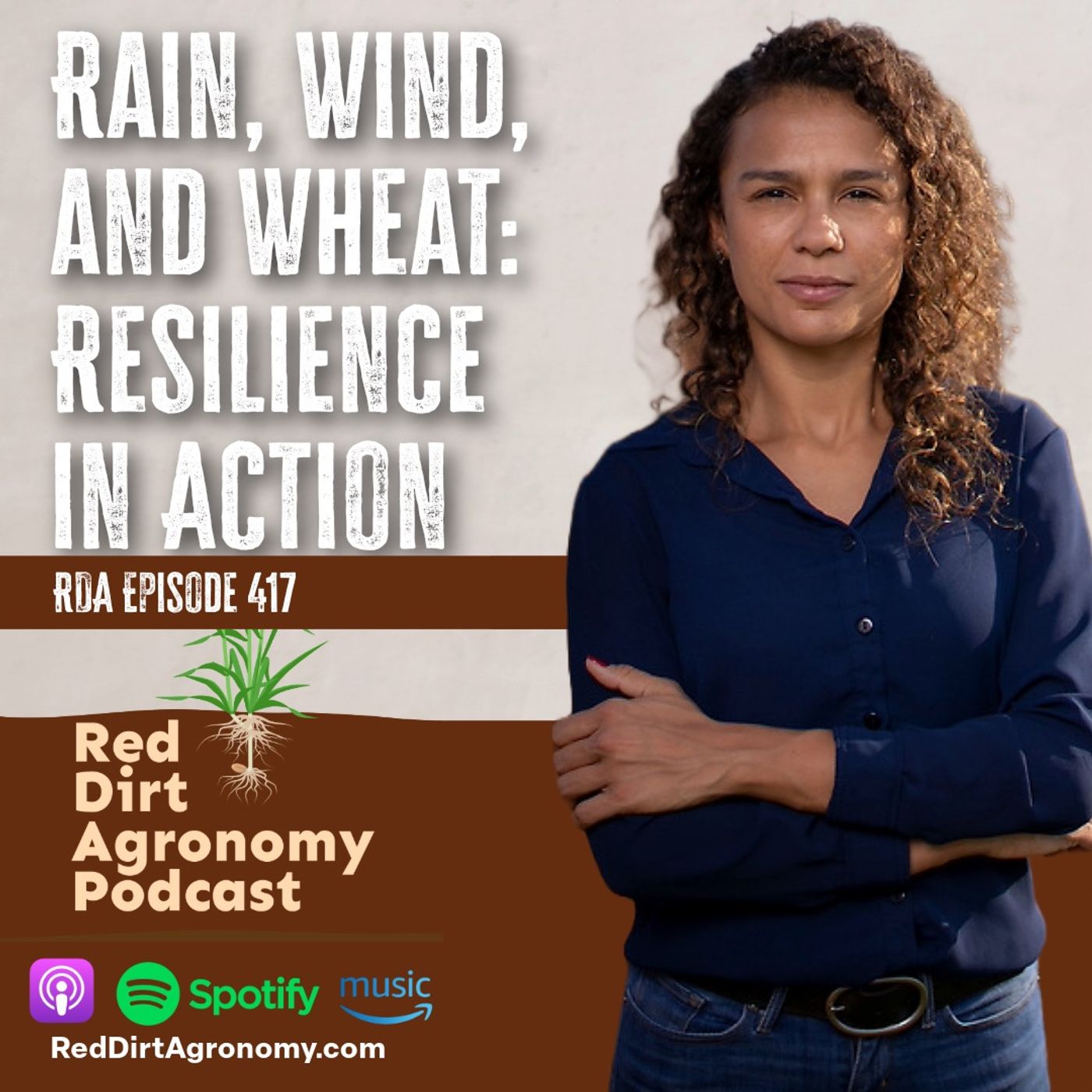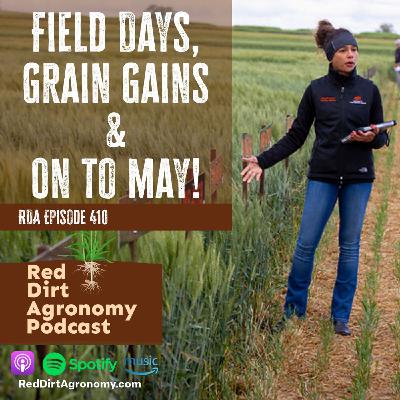Discover Red Dirt Agronomy Podcast
Red Dirt Agronomy Podcast

Red Dirt Agronomy Podcast
Author: Brian Arnall Ph.D., Dave Deken, Josh Lofton Ph.D.
Subscribed: 9Played: 134Subscribe
Share
© 2024 - Ag Now Media LLC
Description
The Red Dirt Agronomy Podcast is your source for in-depth discussions on agronomy explicitly tailored for the unique challenges and opportunities in Oklahoma and the Southern Plains.
Hosted by a team of university experts, this podcast dives into soil health, crop production, pest management, and innovative farming practices, all with a regional focus.
Whether you're a seasoned agronomist, a dedicated farmer, or simply passionate about agriculture in the Red Dirt region, this podcast offers practical advice, expert insights, and the latest research to help you thrive in your field.
Tune in and stay connected to the heart of agronomy in the Southern Great Plains.
Hosted by a team of university experts, this podcast dives into soil health, crop production, pest management, and innovative farming practices, all with a regional focus.
Whether you're a seasoned agronomist, a dedicated farmer, or simply passionate about agriculture in the Red Dirt region, this podcast offers practical advice, expert insights, and the latest research to help you thrive in your field.
Tune in and stay connected to the heart of agronomy in the Southern Great Plains.
73 Episodes
Reverse
This episode of the Red Dirt Agronomy Podcast features Dr. Beatrix Haggard, an associate professor in Oklahoma State University’s Department of Plant and Soil Sciences, whose teaching mission is to make sure students know what plant they’re looking at—and how it works. Dr. Haggard walks us through her journey from FFA land judging in Texas to soil science at Tarleton State and LSU, to a regional soil fertility role in the Louisiana Delta, and finally to a teaching-heavy, tenure-track position at OSU. Along the way, she explains how those experiences shape how she teaches, from intro plant science to senior seminar, crop judging, and soil morphology.The crew also explores major shifts in today’s student body and how they change the way agronomy is taught. They discuss students working full-time jobs while in school, the rise of pre-vet and ag business majors, the growing number of non-traditional and out-of-state students (from California to New York and Indiana), and why judging teams and hands-on greenhouse work are powerful ways to build confidence and real-world skills. If you care about who will be scouting your fields, writing your recs, and leading your ag businesses in 10–20 years, this episode is a great look at how OSU is training that next generation.Top 10 takeawaysTeaching-focused, tenure-track agronomy roles are rare—and powerful.Dr. Haggard holds an 85% teaching appointment at a land-grant university, which she describes as a “unicorn” compared to more common research-heavy roles. That lets her invest deeply in core plant and soil courses that hundreds of students pass through every year.Intro plant science at OSU is huge and foundational.Plant 1213 serves ~600 students a year, mostly freshmen, and often becomes their first exposure to plant science, agronomy and OSU’s ag culture. What happens in that class heavily influences which majors students choose—and whether they ever consider crops or soils.College is about “learning how to learn,” not just memorizing content.Dr. Haggard uses her own career—soil scientist turned crop teacher—to show students that the real value of college is learning how to tackle new subjects and roles. If she can go from soil formation to crop growth stages on the job, they can pivot in their careers too.Judging teams teach life skills: travel, teamwork and resilience.Beyond plant and seed ID, crops and soils judging expose students to long trips, new regions and tight-quarters team dynamics. For some, it’s their first time crossing the Mississippi River or even flying. Dr. Haggard jokes it’s a successful trip if everyone is still talking on the way home.Today’s students juggle far more than class.Many students work full time, commute home on weekends and carry heavy concurrent credit loads from high school. That changes how instructors design assignments and study expectations—“go to the library all weekend” doesn’t match many students’ realities anymore.OSU agronomy is no longer just rural Oklahoma farm kids.The department now attracts students from California, Oregon, Washington, Indiana, Missouri, Arkansas, Kentucky, New York and beyond, plus metro and suburban areas like Edmond and Oklahoma City. Many arrive with little or no farm background, which reshapes how faculty introduce basic equipment and practices.Ag majors are fluid—pre-vet and ag business are big destinations.Dr. Haggard sees many students start in animal science or pre-vet and then migrate to ag business, economics or plant/soil majors once they experience different classes and discover where their interests really lie. Flexibility in degree paths is key.Plain language and memory tricks matter in technical fields.Rather than keeping content “unattainable,” Dr. Haggard leans on layman’s terms and memorable phrases like “all cats manage kittens ammonium naturally” to help students retain complex ideas such as the lyotropic series in soil chemistry. Those small tools make a big difference for freshmen.Extension and classroom teaching are two sides of the same coin.Josh points out that he loves teaching the same agronomic concepts to two very different audiences: landowners and consultants on the extension side, and students in the classroom. The goals and depth differ, but both are about helping people apply agronomy in real life.Stable, passionate teachers anchor a department.Brian notes how important it is for a department to have long-term, high-quality teachers in core classes. With Dr. Haggard and Dr. Abbott, OSU Plant and Soil Sciences has a consistent foundation for teaching the “fundamentals” to every student who comes through the program. Segment Timestamps00:00–02:00 – Opening & introductions02:00–06:30 – What Dr. Haggard teaches at OSU06:30–11:30 – Her path into soils and agronomy11:30–15:30 – First “real” job & learning crops on the fly15:30–19:30 – Why she loves teaching19:30–24:30 – Building a teaching-heavy career at a land-grant24:30–29:30 – How Josh and Beatrix coordinate teaching29:30–26:00 – Judging teams and what students gain26:00–33:30 – How students and learning have changed33:30–36:35 – Who OSU agronomy students are now & close
RedDirtAgronomy.com
Water is life—especially in the Oklahoma Panhandle. In this episode, the Red Dirt Agronomy team welcomes Dr. Sumit Sharma, OSU Extension’s irrigation specialist, for a wide-ranging discussion on how producers can stretch every drop. From pre-watering to planting decisions, Sharma explains how irrigation science is helping producers navigate declining well capacities and unpredictable weather while maintaining strong yields.The conversation also explores cotton and corn management, growing degree days, and the future of sustainable production in Oklahoma’s High Plains. With insights on new technologies, the Master Irrigators program, and the resilience of prairie systems, this episode offers both practical advice and a hopeful look at how farmers can adapt without giving up on the land they love.10 TakeawaysEfficient irrigation is key to sustaining Oklahoma Panhandle agriculture as wells decline.Cotton can thrive with as little as 14 inches of irrigation when managed correctly.Elevation impacts growing degree days, influencing which crops succeed.Pre-watering is vital for establishing crops and managing weeds in sandy soils.Short-maturity cotton varieties may improve harvest success before early freezes.Data and technology (like soil moisture sensors) are transforming irrigation decisions.Regenerative ag and cover crops are helping improve soil health under limited irrigation.Pasture restoration is a long-term solution for lands losing water capacity.The Master Irrigators Program offers farmers education, audits, and financial incentives to conserve water.The Panhandle’s resilience—both ecological and cultural—shows that adaptation is possible even in drought-prone areas.Timestamped Rundown00:00–01:00 – Dave Deken opens Episode 426; sets up discussion on irrigation and underground water.01:00–03:00 – Introductions: Dr. Brian Arnall, Dr. Josh Lofton, Dr. Raedan Sharry; light humor about breakfast and fieldwork.03:30–05:00 – Dr. Sharma joins; recap of his background and move from the Panhandle to Stillwater.05:00–07:00 – Overview of ongoing research: growing corn with limited water, regenerative agriculture, and cotton-water studies.07:00–10:00 – Explanation of growing degree days (GDDs) and how elevation affects crop heat units in Oklahoma.10:00–13:00 – Cotton challenges in high elevation areas; water use comparisons between cotton and corn.13:00–17:00 – Discussion on cotton irrigation timing—why early stress can help root growth.17:00–21:00 – Cotton varieties (Phytogen 205 vs. 411); balancing short vs. long maturity crops.21:00–25:00 – GDD model reliability questioned; differences between Panhandle and southern climates.25:00–29:00 – Deep dive on “pre-watering” in the Panhandle: how much, why, and when.29:00–32:00 – Millet research and unexpected challenges (birds, pigweed, herbicide limits).32:00–35:00 – Discussion on drought, soil loss, and reestablishing pasture for sustainability.35:00–39:00 – Dr. Sharma details the Master Irrigators Program: training, incentives, and upcoming sessions in Altus.39:00–40:30 – Closing remarks and links to RedDirtAgronomy.com.
RedDirtAgronomy.com
The cattle industry is riding high on prices—but running low on cows. In this episode of the Red Dirt Agronomy Podcast, Dr. Derrell Peel, OSU Extension Livestock Marketing Specialist, joins the team to unpack how drought, market cycles, and global trade have shaped today’s record-setting beef economy. Peel explains why herd numbers have fallen to their lowest level in 70 years, and why it could take until the end of the decade to rebuild.From wheat pasture leases to feedlot margins, the discussion dives deep into how grain, forage, and feed costs influence decisions on the ranch. The crew also explores producer strategies in a volatile market—from managing risk to making the call on heifer retention. Whether you’re a cow-calf producer, stocker operator, or just watching the beef prices at the grocery store, this episode brings timely insight into the complex world of cattle markets.Top 10 TakeawaysU.S. beef cow herd is at a 70-year low—the tightest supply in generations.Cattle prices are at record highs, and analysts expect peaks through 2027.Drought forced widespread liquidation, reducing herds beyond intended levels.Herd rebuilding will be slow—likely taking the rest of the decade.Feedlots benefit from cheap corn, extending feed periods to offset low supplies.Beef demand remains strong, even with expensive retail prices and alternatives available.Ground beef drives the U.S. beef market, making up nearly half of consumption.Imports of lean beef add value to U.S. cattle by balancing fat and lean ratios.Market volatility is a growing risk, making risk management crucial for producers.New producers should proceed cautiously, leasing land or starting small before buying high-priced cattle.Timestamps00:00–04:00 – Opening and crop updates from Dr. Josh Lofton: best summer in years, but grain markets are low.04:00–10:00 – Wheat planting delays, moisture variability, and forage conditions across Oklahoma.10:00–12:00 – Crop quality nationwide and tie-in to cattle feed and grain prices.12:00–14:00 – Introduction of Dr. Derrell Peel, OSU Livestock Marketing Specialist.14:00–17:00 – Record-high cattle prices amid record-low inventories.17:00–20:00 – Feedlots thriving on cheap corn; stocker margins tightening.20:00–24:00 – Drought’s impact on herd liquidation; slow path to rebuilding.24:00–28:00 – Consumer beef demand remains strong despite high prices.28:00–32:00 – Myths about government assistance for herd rebuilding.32:00–37:00 – Drought cycles, herd age, and long-term herd quality.37:00–42:00 – Political factors, trade issues, and market volatility.42:00–47:00 – Ground beef’s crucial role and the importance of imports.47:00–51:00 – Restaurant beef prices and consumer demand resilience.51:00–53:00 – Practical advice for new landowners and market timing.
RedDirtAgronomy.com
This week, the crew sits down with Jeff Wright of Oklahoma Foundation Seed to trace the wheat seed pipeline—from a few pounds in the breeder’s bag to the certified seed growers buy. Jeff opens the hood on a weather‑delayed harvest that still posted only ~5% sprout damage and a 56‑lb test weight on Orange Blossom, then tells the highway‑shoulder saga of backing a combine down I‑44 after a trailer failure. He explains the four certified seed classes (breeder → foundation → registered → certified), why purity matters, and how new tools—like fast‑cleaning plot combines and precision planters—help scale a 10–15 lb start into bushels, quicker. Agronomy nuggets abound: skip‑row/wide‑row, ~500k seeds/acre targets, and how partnerships from Hutchinson to Stillwater keep seed flowing across the Plains.Top ten takeawaysThe seed pipeline exists to protect purity—breeder → foundation → registered → certified—so farmers get exactly the genetics they expect.Even in a rough year, Orange Blossom came off with ~5% sprout damage and 56‑lb test weight, underscoring how management and luck intersect.Logistics are real: after losing two trailer wheels, Jeff literally backed a combine down I‑44 to keep harvest moving.Modern gear speeds purity: a Kincaid research combine can be torn down and cleaned in about 1–1.5 hours(often right in the field).Tiny starts can scale fast: planting 10–15 lb with a research planter can produce bushels the next year and accelerate releases like Scab Striker.Low‑pop, wide/skip‑row wheat works—Jeff often targets ~500,000 seeds/acre and still harvests competitive yields.Trait licensing shapes access: certain lines (e.g., DoubleStop, Strad, CoAXium) are certified‑seed‑only or under special contracts.Cross‑state coordination matters: OSU and K‑State swap seed and use Hutchinson, KS, as a hand‑off to serve customers on both sides of the line.Cold storage and national germplasm archives keep legacy varieties alive for future breeding and rescue.The future’s colorful (literally): purple wheats, higher‑fiber lines, and other innovations are on the horizon. Timestamps:00:00–00:18 — Sponsor: Oklahoma Wheat Commission; “feeding the world while growing the future.”00:19–01:20 — Show open, Ep. 424; “lots of wheat going in the ground across the Great Plains.”01:21–02:16 — Team roll call: Dr. Brian Arnall, Dr. Josh Lofton, Dr. Raedan Sharry; booth banter.02:25–03:38 — Meet Jeff Wright, manager of Oklahoma Foundation Seed; recorded at High Plains Journal Live (Wichita).03:39–04:52 — Harvest chaos: cutting delays; “lost two wheels” off the trailer; backed a combine down I‑44 to solve it.04:53–06:10 — What Foundation Seed does: maintain purity, scale new releases, and handle more than wheat (barley, oats, rye, peanuts, mung beans, forage grasses).06:11–08:14 — Weather impact: a late cut still tested ~5% sprout damage and 56 lb test weight on Orange Blossom; theory on staying consistently wet.08:15–12:26 — Jeff’s 18‑year arc (since 2007): from F2 gleaners and all‑day cleanouts to better logistics and later planting windows.12:27–15:06 — Launching varieties faster: from Duster’s slow start to handling 15–10 lb starts across many lines.15:07–17:22 — Research planter tactics: planting ~25 lb over ~2 acres (80 bu the next year) and 15 lb over ~2 acres (later “Scab Striker” at ~90 bu).18:13–19:32 — Equipment leap: Kincaid seed‑production combine (clean in ~1–1.5 hours in the field) and a small 10‑ft header plot machine (30 minutes, one person).20:09–21:11 — Seed classes explained: breeder → foundation → registered → certified; most OSU lines can be saved farm‑to‑farm, with traited exceptions (e.g., DoubleStop, Strad, some CoAXium).21:53–24:26 — How other states do it; crop mixes; Kansas heavy in wheat, Missouri soybeans, Georgia peanuts.24:37–26:06 — Coordination with K‑State and Kansas Wheat Alliance; swap seed and use Hutchinson as a distribution point.26:46–28:06 — Facilities: moved into a new building in 2018; goal to hard‑install cleaning equipment (retire the portable setup).28:36–29:46 — Agronomy: ~500k seeds/acre can still push yield; which plant types handle wider rows/skip rows best (good tillering, wide leaves).30:09–33:05 — When varieties fade: carryover strategy, hauling to the elevator, and keeping small lots in cold storage; national germplasm backup.34:33–35:24 — What’s next: purple wheats, high‑fiber lines, and more CoAXium—“exciting changes ahead.”|36:00–37:30 — Why producer partnerships matter; wrap and contact info
RedDirtAgronomy.com
This week on the Red Dirt Agronomy Podcast, we bring you a wheat-packed episode from High Plains Journal Live in Wichita with Aaron Harries of Kansas Wheat. Aaron takes us on an incredible journey through the world of wheat in Kansas, including how railroads and immigrant farmers have shaped today’s production, and how cutting-edge research is transforming breeding programs. He explains how tools like double haploids and gene editing are speeding up wheat variety development—and why the next decade may be the “golden age” of wheat research.We also dive into Kansas Wheat’s education and outreach programs. From the targeted insights of Wheat Rx to the economic arguments behind “Beyond the Value of the Grain,” Aaron outlines a comprehensive strategy to support producers and inform decision-makers. Add in the pressing threat of wheat streak mosaic virus and how “Fight the Mite” is helping growers combat it, and you've got an episode that’s as informative as it is essential for wheat growers across the Southern Plains.Key TakeawaysKansas Wheat is at the forefront of modern wheat research, embracing tech like double haploids and gene editing.The Wheat Rx program is transforming how growers receive agronomic prescriptions for varieties.“Beyond the Value of the Grain” highlights the agronomic benefits of wheat in rotations.The “Fight the Mite” campaign is helping fight wheat streak mosaic virus via strategic management.Kansas Wheat’s checkoff program funds research based on farmer priorities.Grazing systems and volunteer wheat require a balance of economic opportunity and disease management.There’s growing collaboration between Kansas, Oklahoma, and Colorado wheat researchers.GMO wheat could soon help address viral diseases, but market readiness remains an issue.Educating consumers on the health value of wheat is an ongoing challenge, particularly in light of social media myths.Wheat is still vital to food systems—and its importance must be championed through research, outreach, and innovation. Timestamps00:01:58 – Live from High Plains Journal Live in Wichita00:02:54 – What's on Your Mind podcast and wheat history00:06:02 – Aaron’s role with Kansas Wheat and wheat research funding00:07:38 – Double haploids and advances in wheat breeding00:12:11 – Wheat Rx program and future of precision agronomy00:14:16 – “Beyond the Value of the Grain” campaign00:18:43 – “Fight the Mite” and wheat streak mosaic virus education00:24:09 – Changes in Kansas Wheat and grower attitudes00:27:02 – Collaboration across states and universities00:33:08 – GMO wheat, new markets, and trade outlook00:36:15 – Educating the public and combating misinformation00:40:46 – The impact of social media and future outreach
RedDirtAgronomy.com
This week on the Red Dirt Agronomy podcast, the crew sits down with Dusti Gallagher, CEO of Heartland Plant Innovations, to explore how cutting-edge breeding tools are transforming wheat genetics. From her Oklahoma upbringing to her role in driving biotech advancement in Kansas, Dusti shares the story of how HPI is helping breeders produce better wheat—faster. Using double haploid technology, her team can deliver pure, stable genetic lines in just a year, dramatically reducing development timelines.Dusti also introduces us to HB4 wheat, the first biotech wheat trait deregulated in the U.S., boasting drought tolerance and herbicide resistance. With a strong focus on science-backed innovation and a respect for producers’ concerns about biotech, Dusti and HPI are helping bridge the gap between advanced research and on-farm value. Whether you're a grower or just fascinated by crop science, this is one conversation you won’t want to miss.Key TakeawaysDouble-haploid technology significantly reduces breeding time—often by half.HPI specializes in creating pure wheat lines using early-generation F1 seeds.The corn pollination method is used to initiate the double haploid process.This method ensures genetic consistency without genetic modification.Wheat breeding is catching up to crops like corn in the use of advanced biotech tools.HPI supports both public and private breeding programs across the U.S. and internationally.Speed breeding techniques and environmental controls enhance breeding efficiency.Dusti Gallagher has deep roots in ag policy and wheat industry development.HB4 wheat introduces herbicide resistance and drought tolerance through biotech.HPI is positioning itself to manage biotech traits safely and transparently.Timestamps00:00 – Welcome and High Plains Journal Live intro00:42 – Meet Dusti Gallagher, CEO of Heartland Plant Innovations03:02 – What is double haploid technology?06:20 – How HPI cuts wheat breeding timelines in half08:22 – Speed breeding, single seed descent, and environmental control10:14 – Who HPI works with and what crops they support12:38 – Genetic complexity of wheat and challenges in breeding14:26 – GMO vs. double haploid breeding – clearing up confusion16:48 – Collaborating with breeders like Brett Carver18:19 – Dusti’s journey from OSU to HPI21:03 – Is hybrid wheat finally here?22:09 – HB4 wheat: The first deregulated biotech trait in U.S. wheat24:34 – What’s next for biotech in wheat breeding
RedDirtAgronomy.com
This week’s Red Dirt Agronomy Podcast takes us to the heart of innovation in Kansas agriculture. We caught up with Ray Flickner at High Plains Journal Live, where he shared how his fifth-generation farm blends heritage with high-tech. From running three crops in two years to using cover crops for weed suppression and soil health, Ray’s flexible and moisture-conscious approach proves that success isn’t about rigid rules—it’s about adapting with intent.The highlight? A deep dive into the Rain360 system—a mobile irrigation rig that’s helping Ray make the most of limited water across irregular fields. It’s not just talk; he’s cutting water use by 40% compared to local averages. If you're farming in the Southern Plains or just looking for fresh ideas, this episode delivers practical, tested insights you can take straight to the field.Key Takeaways Ray Flickner farms 1,000 acres with a strong focus on irrigation efficiency and strip tilling.He operates with limited livestock in a region where integrating animals is logistically difficult.Ray uses wheat as a functional cover crop to maintain soil health and “living roots.”Cover crop termination timing is critical and must be adapted to seasonal moisture.Rain360 is a mobile, above-ground irrigation system designed for irregular fields and low water flow.The system can deliver both water and nutrients precisely where they’re needed.Subsurface drip irrigation has helped Ray reduce water usage by approximately 40%.Strategic use of irrigation timing and moisture sensors boosts efficiency.The farm serves as a demonstration site for innovative irrigation practices.Ray’s adaptive management style reflects a balance between innovation and practicality.Timestamps00:03:06 – Introduction to Ray Flickner and his background00:04:25 – Ray’s family farm history and crop rotation strategy00:07:04 – Strip tilling advantages and fertilizer placement00:08:32 – Managing three crops in two years with limited moisture00:10:58 – Cover crop strategies and moisture-driven termination decisions00:14:41 – Installing and operating the Rain360 irrigation system00:20:00 – Water efficiency challenges with limited aquifer access00:26:49 – Beta testing setbacks and successes with new irrigation tech00:30:26 – Subsurface drip irrigation’s impact on sustainability00:31:47 – Closing thoughts and reflections on farming innovation
RedDirtAgronomy.com
This episode hits the road to Wichita, Kansas, where the Red Dirt Agronomy team joins High Plains Journal Live and connects with growers, ag researchers, and industry leaders from across Oklahoma and Kansas. Executive Director of the Oklahoma Wheat Commission, Mike Schulte, joins the crew to share invaluable insights on wheat variety development, global markets, and the innovative ways Oklahoma State University's wheat breeding programs are shaping the future of the crop.From dual-purpose wheat suited for both grain and grazing, to tackling issues like wheat streak mosaic virus, Mike explains how Oklahoma’s public wheat research and producer-led funding are creating solutions for modern farming challenges. He also touches on exciting progress in high-fiber wheat development aimed at improving health outcomes, and how the commission balances wheat as a commodity and a specialized product. If you're interested in market shifts, consumer trends, or how OSU is leading wheat innovation, this is a can't-miss conversation.Key TakeawaysOklahoma wheat breeders are releasing more varieties annually than most public programs nationwide.The "Breakthrough" variety is helping farmers manage wheat streak mosaic virus.OSU is the only U.S. institution actively breeding wheat for grazing-grain dual purpose.High-fiber wheat is being developed to tackle major health issues like diabetes and heart disease.U.S. wheat, including Oklahoma’s, is regaining global competitiveness thanks to favorable pricing.Mexico remains Oklahoma’s top wheat market, with Ecuador and Peru growing fast.The Commission supports clean-label initiatives by reducing gluten additives through better breeding.Over 60% of Oklahoma wheat is expected to enter the export market this year.Wheat marketing now focuses more on quality and end-use differentiation than in the past.Publicly funded wheat research enables innovation tailored to Oklahoma’s unique conditions. Timestamps00:00 – Intro from the High Plains Journal Live event00:57 – Meet Mike Schulte, Executive Director of the Oklahoma Wheat Commission03:37 – Importance of showing up in Kansas: reaching more Oklahoma wheat producers05:02 – Oklahoma Genetics wheat varieties and their adaptation ranges06:15 – Breakthrough wheat for wheat streak mosaic virus control07:54 – How the Commission’s mission evolved over 18 years09:45 – Cleaner labels and gluten sensitivities: breeding better wheat11:04 – Explaining wheat as a commodity vs. specialized crop13:47 – Quality testing and how wheat samples are tracked15:08 – International market expansion in Central and South America17:07 – Why U.S. wheat is now competitive again globally19:36 – Export vs. domestic usage percentages for Oklahoma wheat22:16 – Grazing grain varieties and beef integration25:08 – Public vs. private wheat research and OSU’s impact
RedDirtAgronomy.com
The Red Dirt Agronomy Podcast team traveled to Wichita for High Plains Journal Live, where they sat down with Dr. Shannon Ferrell of Oklahoma State University. In this lively conversation, Dr. Ferrell dives deep into the realities of farm succession planning, from the traditional “farm kid vs. city kid” dilemma to the increasingly common “no heirs returning” challenge. He explains how recent legislative changes in the “One Big Beautiful Bill” affect payment limits for LLCs, estate tax exemptions, and spousal portability—critical details for farm families planning their future.The discussion also turns toward energy, with a look at the booming solar industry, the economics of battery storage, and what the phase-out of renewable tax credits might mean for rural Oklahoma. Dr. Ferrell offers a bold proposal for modernizing transmission easement compensation, encouraging landowner participation in much-needed infrastructure projects. Whether you’re thinking about passing down your farm or eyeing new opportunities in renewable energy, this episode is packed with insights you can use.Key TakeawaysFarm transition planning is shifting from farm kid vs. city kid challenges to situations where no heirs return to the operation.LLCs can now receive combined payment limits for partners, removing a barrier to certain succession structures.Estate tax exemption rises to $15M per individual in 2026, with spousal portability ensuring up to $30M passes tax-free.Gift tax exclusions allow $19,000 per person annually without impacting the unified credit.Renewable energy development in Oklahoma remains strong despite upcoming tax credit phase-outs.Solar power costs have plummeted globally, with innovative uses emerging.Battery storage is now economically viable, making renewable power dispatchable.Phase-out of federal tax credits may alter investment patterns but likely won’t halt projects.Transmission easement models may need modernization to include ongoing revenue for landowners.Distributed generation could reduce long-distance transmission needs, but grid resilience still requires infrastructure expansion.Timestamps00:00 – Live from High Plains Journal Live in Wichita, KS02:00 – Introducing the Dream Team of Dirt03:15 – Dr. Shannon Ferrell’s summer speaking tour highlights04:39 – Farm succession planning: Farm kid vs. city kid dilemma06:32 – No heirs returning: options for farm asset transitions08:14 – “One Big Beautiful Bill” and changes to payment limits for LLCs09:14 – Estate tax updates and spousal portability explained13:49 – Gift tax rules and unified credit in farm succession15:15 – Tax provisions that impact transition planning15:46 – Renewable energy development: wind, solar, and batteries18:08 – Phase-out of renewable energy tax credits and industry impacts20:36 – Battery storage economics and dispatchable power22:15 – Tariffs, supply chains, and domestic manufacturing for energy tech25:18 – Transmission easements and incentivizing landowners27:38 – Distributed generation and grid resilience28:21 – Wrapping up the Summer Ferrell Tour
RedDirtAgronomy.com
In this episode of Red Dirt Agronomy, the team sits down with Casey Hentges, host of Oklahoma Gardening, to celebrate the show's 50th anniversary. From its humble beginnings with live OETA broadcasts to its reach of millions globally via YouTube, Oklahoma Gardening has become a staple in the horticulture community. Casey shares her unique journey through horticultural landscapes—commercial, educational, and nonprofit—ultimately leading to her ten-year tenure as the longest-running host of the show. She reflects on the evolution of gardening communication, the importance of adapting content for new audiences, and her dedication to showcasing Oklahoma’s diverse horticultural practices.Listeners will also hear about the behind-the-scenes strategies that keep Oklahoma Gardening fresh, fun, and science-based, including recreating classic segments and addressing common myths, such as the use of vinegar as an herbicide. Casey highlights how the show navigated challenges during the COVID-19 pandemic, kept community engagement alive, and launched initiatives like "Plant a Row" to support local food banks. Plus, they’re giving away a tiller and releasing a co-branded Eskimo Joe’s shirt to mark the 50th anniversary. It's a fun, informative episode that honors the past while looking ahead to the future of gardening education in Oklahoma.10 Key TakeawaysOklahoma Gardening celebrates 50 years of horticultural education.Casey Hentges is the longest-running host in the show's history.The show maintains freshness by blending classic segments with new content.It prioritizes science-based gardening advice over trending myths.COVID-19 prompted innovative backyard filming and remote collaboration.Gardening interest surged during the pandemic.They conducted 96-plot Bermuda grass removal demonstrations.The show reaches 3–4 million global views annually on YouTube.Initiatives like “Plant a Row” encourage community food donations.A limited-edition Eskimo Joe’s x Oklahoma Gardening shirt supports the show and student farm.Timestamps00:00 – Intro and upcoming Highland Journal Live Event07:17 – Welcoming Casey Hentges10:13 – Casey’s journey from OSU grad to TV host17:47 – Oklahoma Gardening’s 50th Anniversary celebration22:35 – Staying fresh with recurring garden topics24:50 – Addressing gardening myths and misinformation26:59 – Bermuda grass removal trials34:30 – COVID adaptations and new outreach strategies42:07 – Global reach and viewer demographics45:00 – Plant a Row campaign and tiller giveaway46:42 – Eskimo Joe’s co-branded shirt launch
RedDirtAgronomy.com
Oklahoma wheat growers have faced a wild ride this season—droughts, floods, wind, and more. In this episode, Dr. Amanda Silva from OSU Extension joins the Red Dirt Agronomy crew to unpack the 2025 wheat harvest and the unexpected resilience of this year’s crop. We hear from Dr. Josh Lofton and Dr. Brian Arnall as they reflect on the evolution of modern wheat management and share insights from statewide variety trials, nitrogen studies, and the ever-challenging Oklahoma climate.You'll also get an exclusive preview of an upcoming hands-on sorghum event in Woods County on July 29, offering growers and consultants a chance to get dirty and dive deep into forage quality, nitrate testing, and in-field crop assessments. Whether you're scouting sorghum or pondering wheat seeding rates, there's something for everyone in this packed episode.Key TakeawaysOSU is hosting a hands-on sorghum event in Woods County on July 29.Many summer crops in Oklahoma are doing better than expected due to timely rainfall.The wheat harvest has been delayed due to persistent rain and field saturation.Some wheat fields experienced up to 40% shattering from storm damage.Intensive management, especially timely nitrogen application, led to significantly higher wheat yields.Wheat planted at lower seeding rates in late season performed similarly to higher rates.Variety and planting date flexibility helps manage environmental risks.Genetic flexibility in newer wheat varieties may be increasing productivity.OSU is expanding trials to further study wheat population and fertilizer timing.Growers are reminded that no growing season is typical—adaptability is key.Episode Timeline00:00:02 – Welcome & Episode Tease00:01:11 – OSU Specialists Join the Table00:01:58 – Sorghum Event Announcement00:03:02 – What to Expect at the Sorghum Field Day00:05:39 – Event Logistics & Registration00:07:28 – Summer Crops Update00:08:46 – Early Corn Success in Southwest Oklahoma00:12:08 – Corn Equipment Shortage00:15:12 – Challenges for Cotton and Late-Planted Soybeans00:17:58 – Wheat Harvest Delays00:20:55 – Understanding Test Weight Loss00:22:06 – Hail, Wind & Shattering Losses00:25:17 – Managing Secondary Tillers at Harvest00:27:10 – Desiccation and Public Perception00:30:22 – Wheat Variety Trial Takeaways00:32:01 – Nitrogen Timing Wins the Day00:33:00 – Rethinking Seeding Rates00:36:44 – 2025–2026 Wheat Research Preview00:40:01 – What's Driving Big Yields?00:43:19 – Comparing Grain Quality in Tillers vs. Main Stems00:44:18 – Reflecting on the 2025 Wheat Crop00:46:25 – Agronomic Deja Vu00:47:15 – Accessing Wheat Trial Data
RedDirtAgronomy.com
This episode of the Red Dirt Agronomy Podcast brings turf science to the forefront with Dr. Charles Fontanier from Oklahoma State University. As the summer season sets in and Oklahoma’s golf courses and athletic fields buzz with activity, the discussion centers around the strategic development and management of Bermuda grass varieties bred to thrive in Oklahoma’s unpredictable climate. Dr. Fontanier shares how OSU’s turfgrass research addresses winterkill, drought resilience, and the demand for tough, low-maintenance grasses that can still look good and perform under pressure.From NFL stadiums to backyard lawns, OSU's impact is growing. You will hear about standout varieties like Tahoma 31 and Latitude 36 and learn how science and collaboration have positioned OSU at the forefront of turf innovation. Whether you're a turf manager, landscaper, or just passionate about keeping your lawn green through the extremes, this episode delivers insight with practical relevance.Key Takeaways:OSU's turfgrass program focuses on Bermuda grass improvement for diverse uses.Oklahoma’s climate presents unique challenges for year-round turf maintenance.Latitude 36, NorthBridge, and Tahoma 31 have reshaped the industry.Tahoma 31 offers improved cold and drought tolerance.OSU emphasizes broad adaptability for national impact.Turf management varies significantly between homeowners and sports professionals.Sod distribution networks are essential for local turf availability.NFL and major stadiums use hybrid Bermuda for its resilience.Turfgrass breeding today focuses on low-input, sustainable systems.The economic and ecological stakes of turfgrass are deeply tied to local communities. Timestamps:00:02 – Introductions and episode preview02:30 – OSU’s turfgrass breeding and management research03:47 – Transition zone challenges and winterkill in Bermuda06:06 – Turf management tips for homeowners and superintendents08:13 – The rise of hybrid Bermuda for putting greens10:36 – Development and applications of Latitude 36, NorthBridge, and Tahoma 3113:05 – Trialing new varieties and OSU’s nationwide testing approach17:35 – Seed vs. sod and local turfgrass availability22:04 – Turf in sports stadiums and artificial vs. natural debate27:04 – Maintenance economics and year-round field management34:00 – Water-saving turf strategies and future of turf research
RedDirtAgronomy.com
In this episode of Red Dirt Agronomy, the team sits down with Dr. Jayson Lusk, Vice President and Dean of Agricultural Programs at Oklahoma State University, for a wide-ranging conversation on the future of agriculture and leadership in higher education. Dr. Lusk reflects on his journey from researcher to administrator, the challenges of guiding a land-grant institution, and how he stays grounded in the needs of Oklahoma's producers. The discussion explores the evolving role of faculty engagement, the value of public communication, and how Extension can remain impactful in an increasingly digital world.The episode also covers Dr. Lusk's strategic vision for OSU agriculture, including plans to revitalize off-campus facilities, launch a beef center of excellence, and leverage big data and AI to support producer decision-making. With insights into the delicate balance of university leadership and the importance of staying connected with faculty and stakeholders, this conversation offers practical value for anyone invested in the future of agricultural research and outreach.Key Takeaways Leadership Through Service: Dr. Lusk's path to administration was driven by a desire to amplify impact, not personal ambition.Extension Still Matters: Public-facing efforts like podcasts and producer engagement remain central to OSU’s land-grant mission.Strategic, Not Micromanaged: Dr. Lusk emphasizes empowering faculty and fostering collaboration over top-down control.From Data to Decisions: OSU aims to invest in tools that help producers turn data into practical, on-farm choices.Modernizing Infrastructure: Upgrading aging research farms and facilities is a top priority to support future ag innovation.Beef and Wheat Focus: Strategic investment is centered on Oklahoma’s two leading ag sectors—cattle and wheat.Funding Realities: OSU’s ag programs benefit from strong state support, offering resilience amid federal funding uncertainty.Collaboration Counts: Lusk believes faculty success drives college success—and that includes interdisciplinary teamwork.Measuring Impact, Not Just Output: Dr. Lusk calls for better ways to reward high-impact work that goes beyond publication metrics.Producers as Stakeholders: Oklahoma taxpayers fund OSU’s ag work, and deserve results they can see in the field.Timestamps:00:04 - Welcome and episode intro03:16 - Dr. Lusk’s path from faculty to administration07:08 - Strategic decisions in leadership roles13:33 - Navigating university structure and transitions18:42 - Measuring impact in research and extension30:56 - Challenges and strategy behind the new OSU Ag Hall34:28 - Dr. Lusk’s strategic vision for OSU Agriculture38:24 - The future of ag data, decision tools, and AI
RedDirtAgronomy.com
In Episode 414 of the Red Dirt Agronomy podcast, the team dives deep into the current cotton season in Oklahoma with Dr. Jenny Dudak, Oklahoma State University’s Extension Cotton Specialist. The conversation kicks off with a crop update from Dr. Josh Lofton, who notes mixed outcomes across wheat and summer crops, and a challenging planting season influenced by erratic rainfall. Dr. Brian Arnall and Dr. Raedan Sharry contribute technical insights on soil nutrient conditions and weed management tactics.Dr. Dudak shares her perspective on the cotton planting outlook across Oklahoma, detailing issues like thrips, herbicide resistance, and the narrow windows available for cotton growers in different regions. She also discusses how new technologies and research, including residual herbicides and skip-row planting studies, could help producers cut costs while improving yield reliability. The conversation closes with thoughts on the long-term viability of the cotton industry and its infrastructure in Oklahoma.Timestamps:(00:03) Welcome and podcast intro(01:30) Crop update and planting challenges(07:00) Weed control concerns in double crops(11:45) Cotton planting status and early-season issues(13:00) Scouting for thrips and weed competition(18:00) Overview of Dr. Dudak’s background and research focus(27:00) Cotton expansion into northern territories and risk factors(38:30) Emerging cotton technologies and herbicide advancements(41:00) Cotton vs. corn in southwestern Oklahoma(45:00) Cotton infrastructure and future outlook
RedDirtAgronomy.com
This episode of Red Dirt Agronomy brings the guys together to tackle the stormy spring season in Oklahoma. With wheat harvest creeping closer, sorghum and soybeans struggling for traction, and cotton still holding on to potential, the conversation focuses on the realities producers are facing in muddy fields. Herbicide failures, crop emergence, and tight planting windows make for a strategic balancing act.The episode also welcomes Dr. Tieneke Trotter, a visiting scientist from Central Queensland University in Australia. Dr. Trotter offers a fascinating look into her work developing sesame as an emerging crop in the harsh northern regions of Australia. Her perspective connects the dots between farming systems across hemispheres, from shared pest challenges to a global push for crop diversification and youth engagement in agriculture. Key TakeawaysRain continues to delay planting and disrupt herbicide schedules.Wheat maturity and quality vary widely across Oklahoma.Cotton growers may still have time to plant with minimal impact on yield.Sorghum and soybean replanting come with increased risk.Corn remains the most stable summer crop this season.Dr. Trotter is researching sesame as a climate-resilient crop in northern Australia.Pest pressure and herbicide resistance are significant concerns for sesame.Crop judging programs are being revitalized in Australia.Visiting researchers foster international ag collaboration and innovation.Living in Stillwater offered new perspectives on U.S. ag life for Dr. Trotter and her family.Timestamps00:00 – Introduction and opening banter00:54 – Oklahoma crop and field condition updates03:12 – Herbicide challenges due to excess rain05:30 – Sorghum and soybean replanting risks06:18 – Wheat progress and patchy field reports09:45 – Timing and temperature concerns for cotton11:32 – Rain impacts on pre-emergent effectiveness13:05 – Tips for replanting decisions and herbicide strategy18:36 – Introduction of guest Dr. Tieneke Trotter21:40 – Australian ag background and cropping systems26:51 – Sesame as an emerging crop in Australia32:00 – Pest management and weed pressure in sesame35:45 – Crop judging revival in Australia40:10 – Cultural insights from living in Stillwater44:38 – Agronomy collaboration between countries47:15 – Closing thoughts and wrap-up
RedDirtAgronomy.com
In Episode 412 of the Red Dirt Agronomy Podcast, the team is joined by Mark Hodges, Executive Director of Oklahoma Genetics Inc., for a deep dive into the vital link between OSU wheat research and Oklahoma producers. With decades of experience in both academia and the private sector, Mark outlines how OGI ensures OSU’s cutting-edge wheat varieties reach producers and remain competitive in a rapidly evolving market.The episode highlights the impact of Dr. Brett Carver’s nationally and internationally recognized breeding work, the growing emphasis on quality traits, and the importance of adapting to Oklahoma’s diverse wheat production environments. Listeners will gain insight into how public breeding programs like OSU’s can compete with private industry while delivering real-world value to producers both in Oklahoma and beyond. 10 TakeawaysOGI plays a vital role in connecting OSU wheat research to producers through variety promotion and licensing.Dr. Brett Carver’s leadership has transformed OSU’s wheat breeding into an internationally respected program.Quality traits like milling and baking performance are increasingly important in wheat breeding.OSU wheat varieties dominate Oklahoma’s planting landscape, covering around 70% of acreage.The breeding program incorporates feedback from both producers and end users, including millers and bakers.OGI reinvests its revenues into OSU’s research programs, supporting long-term innovation.Wheat production strategies vary across Oklahoma, from dryland to irrigated and forage-focused systems.New varieties are developed with specific markets and applications in mind, not just general use.Oklahoma wheat has a global footprint, with exports reaching markets across multiple continents.The future of wheat breeding is bright, with continued innovation tailored to producer profitability.00:00 – Welcome and intro to the episode’s focus02:00 – Meet Mark Hodges, Executive Director of OGI04:00 – The critical role of Dr. Brett Carver in wheat breeding06:30 – How OGI supports OSU’s wheat program08:00 – Industry-driven improvements in variety development10:00 – Adapting to Oklahoma’s diverse wheat-growing conditions13:00 – The dominance of OSU-bred varieties in Oklahoma fields17:00 – The rising importance of specialty traits and end-user feedback20:00 – Success in Texas and beyond23:00 – Looking ahead: The future of OGI and wheat breeding
RedDirtAgronomy.com
This week on the Red Dirt Agronomy podcast, the "Doctor's of Dirt, & Everything That Grows From It" talk about the southwest corner of the state—where the cotton fields stretch wide and the water’s been mighty scarce. Dr. Brian Arnall, Dr. Josh Lofton, and Dave Deken catch up with Maxwell Smith, the IPM specialist working boots-on-the-ground in Altus. Maxwell breaks down the unique challenges of farming cotton in a region where irrigation depends on the Lake Lugert-Altus canal system—and where just a few inches of water can make or break your season.They talk through the nuts and bolts of the irrigation setup, why cotton works (when it works), and what’s pushing some farmers to roll the dice on dryland corn. You’ll also hear why herbicide resistance is bringing back “old-school” weed control, how new cotton trait tech like ThriveOn is changing early-season insect control, and what the future looks like for peanuts in Caddo County. If you grow cotton, peanuts, or anything under hot skies and dry dirt, this episode's got your name on it.[00:00–02:00] Max Smith on Altus, cotton, and canal-fed irrigation[03:00–06:00] Allocation math, irrigation upgrades, and lining the ditches[06:30–10:30] Cotton economics, price drops, and crop-switching trends[11:00–16:00] IPM 101: Bugs, weeds, and managing the early season[16:30–20:00] Trait tech: What’s working, what’s not, and what’s next[20:30–24:00] Rotation talk: Corn, cotton, and keeping weeds guessing[24:30–29:00] Peanuts in Oklahoma: acreage trends, water woes, and weeds
RedDirtAgronomy.com
Get ready for a boots-on-the-ground update straight from the Oklahoma wheat fields! Dave Deken, Dr. Brian Arnall, and Dr. Raedan Sharry sit down with Dr. Amanda Silva at the Chickasha Research Station to talk all things wheat — from field day opportunities, intensive and traditional management strategies, to the latest on planting dates, nitrogen management, and the importance of first hollow stem timing. They dive into how small changes in management can make or break a wheat crop, especially after a rollercoaster weather year.Hear the latest research insights, the real-world challenges facing Oklahoma wheat growers this season, and how producers are using tools like text updates to stay informed. Whether you’re in the tractor, scouting fields, or planning for next season, this episode is packed with practical knowledge, expert advice, and a few laughs along the way.Timestamps for the Episode00:00 – Welcome from Chickasha Research Station and intro to field day insights00:39 – Dr. Arnall: Why field days matter for producers and researchers01:49 – Dr. Silva: Learning from producers and adjusting research02:07 – Discussing wheat varieties and intensive vs. traditional management03:51 – Stripe rust impacts and the power of fungicide management06:04 – Making fungicide decisions in stressed wheat crops08:06 – Current wheat conditions across Oklahoma10:57 – Planting struggles and recovery after heavy rains12:20 – Weed challenges and herbicide timing issues13:32 – Planting date research: Extending the season into December14:56 – Seeding rate findings and adjusting nitrogen management20:39 – Yield surprises from delayed planting dates22:23 – First Hollow Stem timing and management strategies26:44 – New text alert system for Oklahoma wheat producers30:15 – Final thoughts and wrap-up
RedDirtAgronomy.com
This week on the Red Dirt Agronomy Podcast, we dig into an exciting alternative crop with real potential for Southern Plains producers—camelina. Host Dave Deken is joined by Amanda Duvall and the Red Dirt dream team—Dr. Josh Lofton and Dr. Raedan Sharry—for an eye-opening discussion on how camelina is reshaping crop rotation conversations. From its weed control benefits and wide planting window to its growing market in sustainable aviation fuel, this oilseed crop is gaining serious ground.Whether you're battling failed wheat acres, chasing new income streams, or simply exploring agronomic flexibility, camelina might just be your new go-to. Amanda breaks down the crop's adaptability to various tillage systems, its drought tolerance, and how it integrates with grazing and cover crop strategies. With harvesting before wheat and low input requirements, it’s a crop that offers profitability without complexity.
RedDirtAgronomy.com
Join us as we explore Jessica’s inspiring journey from eastern Oklahoma to becoming an integral part of a diversified farming operation in the northwest. She shares her experience transitioning from the wetter, more humid climate of eastern Oklahoma to the drier conditions of the west, adapting to new challenges in soil health, crop insurance trends, and unpredictable weather patterns. With deep roots in agriculture, Jessica and her husband, Clint, have grown their operation while raising a family that values hard work and the land.We also dive into the benefits of no-till farming, how soil conservation plays a key role in long-term sustainability, and what it takes to balance farming, family, and a career in crop insurance. Jessica reflects on her time at the assessor’s office, where she gained valuable insights into her new community in Major County. Plus, we reminisce about our days working together at OSU under Dr. Karen Hickman. Don’t miss Jessica’s take on the power of networking among producers and how changing weather patterns continue to shape the future of agriculture in Oklahoma.
RedDirtAgronomy.com


